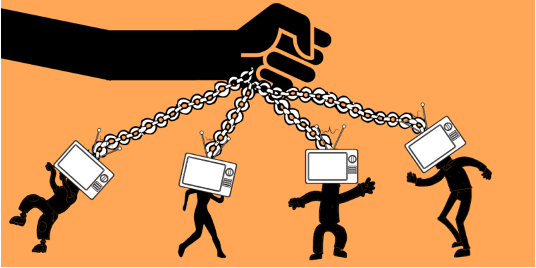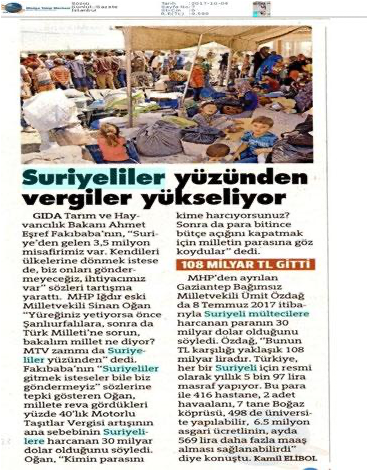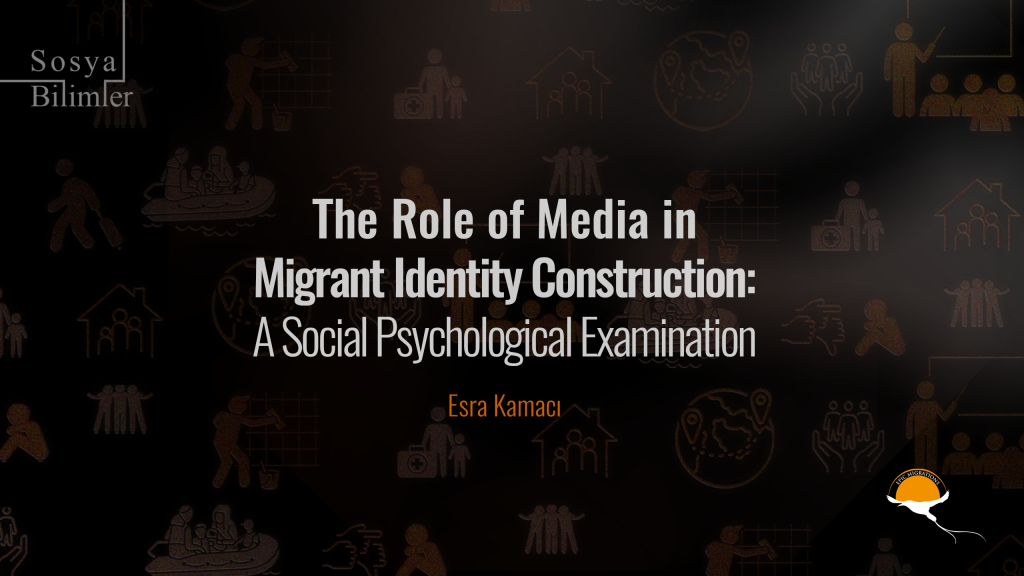Writer: Esra Kamacı
Translator: Sümeyye Öztürk
In addition to being a mass media that enables us to be aware of current innovations, the media is an important institution that affects our open/implicit attitudes and is also considered as an object of research in this respect. The media, which we are exposed to through many tools in our daily lives, directs society on many issues. Of course, the media uses certain strategies while making these directions. It is possible to observe the traces of the basic theories and theories of social psychology in which human tendencies are explained in the relationship between media and society.
It should be recalled that a two-sided legitimization process prevails in the media and human relations. While people support media content that feeds their tendencies and affirms themselves at some points; The media aims to direct more and to be watched / read / demanded more by using these tendencies of people. In this bilateral relationship, it is a crucial step for the individual to be aware of his own psychological tendencies and that they are used by many institutions. Therefore, I will try to detail the relationship between the media and our attitudes with three basic theories/concepts.

First, we can talk about the social identity theory, which is the most basic theory of social psychology. Social identity theory, created by Henri Tajfek and John Turner in the 1970s, has a prominent place in explaining intergroup processes. This theory, which shows how the individual constructs differences between the group he thinks he belongs to and the group he does not belong to, has a prominent place in understanding the relationship between local people and immigrants and comprehending the strategies of the media at this point. Social identity theory speaks of many processes and tendencies. These tendencies are seen in scenarios where there are groups that the individual divides as us/them and there is a comparison between us and them (Tajfel, 1979). The individual tends to see well the group to which he belongs. Especially against the groups he defines as a part of his self, the individual has incredibly positive judgments. In addition, while the individual sees external causes as the cause of the situation that happens to his own group, which is the inner group, or that occurs in the negative situations conducted by the inner group; defines the other as the cause of the negative situations conducted by the external group/members themselves. While the other(s) we call the outgroup are a group whose individuals are not believed to be different and whose individuals we tend to homogenize; we, the ingroup, are described as a group of rich diversity among its individuals (Brewer, 1979). In addition, the individual tends to see significant differences between the ingroup and the outgroup, often groups and individuals are not so different from each other (Jetten, Spears, Manstead, 1997). Our human tendencies and characteristics observed in social identity theory are reinforced by the media. The fact that ethnic origins such as Turks/Syrians/Afghans are given in news texts, even if they have nothing to do with the news content, is a step-in term of increasing ingroup/outgroup biases and reinforcing group identities. At the same time, when the media speaks of the outgroup(s), it also presents a subtext that all the individuals in the outgroup are the same. News texts with large generalizations support our homogeneous perception of the outgroup. The fact that the crimes/negative actions carried out by the ingroup are attributed to external causes such as insanity, momentary heedlessness, psychological illnesses, economic difficulties, and that on the other hand, the negative action of a person from the immigrant group is presented and such reasons are not presented also indicate a tendency that social identity theory envisions; While the reason for the negativities carried out by the inner group is external and the reason for the positive actions is internal, the reason for the negativities performed by the external group is presented as the internal causes of the group and the reason for the positive actions is presented as external causes and the environment.

Another theoretical information that the media often uses is the theory of legitimizing the system. With the theory of legitimizing the system described by Jost and Banaji (1994), it is explained how both those who have the disadvantage and those who do not have it legitimize the ongoing system. When the individual knows that the problems are the fault of the system or does not want to change the existing system, he also legitimizes his own position by arguing that the system is legitimate. It is also possible to say that the individual needs it at certain points, but it seems important to note that this situation prevents the story of large groups affected by the bad aspects of the system from changing. Since the individual is aware of this need, the media presents the individual with a story that legitimizes the system and the individual as an important way to increase their traceability. The legitimization of the difficulties that develop independently of the individual, such as war, climate crisis and economic difficulties that cause migrants to reach their basic human rights or cause them to migrate from their countries, also exonerates the individual who does not act in an activity to prevent the situation of migrants. Based on this theoretical basis, it seems necessary to talk about the conceptualization of belief in a just world. The belief in a just world offers us a vision of a world in which the horrific events experienced by the individual are caused by the individual’s own fault and where everyone is given a fair trial. This situation creates an environment of psychological trust with the illusion that if the individual is good, he will live a good life, and holds people who already have bad experiences responsible for these experiences (Lerner, 1980). If the individual holds the immigrant individual responsible for the negativities experienced by the immigrant, the need to make a political criticism and opposition is eliminated and the system is taken to a legitimate ground by the individual in this way. In this context, the host society adopts an accusatory attitude towards the immigrant and claims that the reason for the situation is again the immigrants. With many arguments such as not showing a political opposition, fighting, not developing, immigrants are criticized and blamed, and the basic systemic problem is ignored. Thus, individuals in the host community do not feel the need for a rejection and do not try to improve the experiences of immigrants. They justify their refusal to engage in this endeavor through the belief in a just world. At this point, the media supports our perception of belief in a just world by presenting the immigrants they claim to be guilty of and specifically referring to these individuals as immigrants. For the negativities experienced by migrants after coming to the host country, presenting reasons such as intellectual backwardness, cultural / linguistic inadequacy, failure is seen as ignoring the negativities of the host society and blaming the victim again, and the use of these expressions by the media is supported by this tendency of the individual.
psychological trust with the illusion that if the individual is good, he will live a good life, and holds people who already have bad experiences responsible for these experiences (Lerner, 1980). If the individual holds the immigrant individual responsible for the negativities experienced by the immigrant, the need to make a political criticism and opposition is eliminated and the system is taken to a legitimate ground by the individual in this way. In this context, the host society adopts an accusatory attitude towards the immigrant and claims that the reason for the situation is again the immigrants. With many arguments such as not showing a political opposition, fighting, not developing, immigrants are criticized and blamed, and the basic systemic problem is ignored. Thus, individuals in the host community do not feel the need for a rejection and do not try to improve the experiences of immigrants. They justify their refusal to engage in this endeavor through the belief in a just world. At this point, the media supports our perception of belief in a just world by presenting the immigrants they claim to be guilty of and specifically referring to these individuals as immigrants. For the negativities experienced by migrants after coming to the host country, presenting reasons such as intellectual backwardness, cultural / linguistic inadequacy, failure is seen as ignoring the negativities of the host society and blaming the victim again, and the use of these expressions by the media is supported by this tendency of the individual.
The psychological tendencies of man have been and will be used in a pragmatic way by many institutions such as the media. While the media conveys the illusion that the individual is right instead of reminding them of their responsibilities to be read / watched more; In this illusion, man is at peace of finding a way to justify himself and the discriminatory attitudes he has conducted. In this bilateral relationship, there is a hatred that is built up and then has behavioral negative consequences. Of course, within this relationship, it is possible to offer a rational and fair perspective on the current situation. As human beings, being aware of these tendencies and relying more on researched sources and information is the first way to do this. I think it would not be wrong to say that the media will present news in favor of itself, but it is of course possible for us as individuals to provide a more rights- and responsibility-oriented stance on this issue.
BIBLIOGRAPHY
Brewer, B.M. (1979). In-group bias in the minimal intergroup situation: A cognitive-motivational analysis. Psychological Bulletin, 86(2), 307–324.
Jetten, J., Spears, R., & Manstead, A. S. R. (1997). Strength of identification and intergroup differentiation: The influence of group norms. European Journal of Social Psychology, 27(5), 603–609.
Jost, J. T., & Banaji, M. R. (1994). The role of stereotyping in system‐justification and the production of false consciousness. British Journal of Social Psychology, 33(1), 1-27.
Lerner, M. J. (1980). The belief in a just world. In The Belief in a just World, 9-30.
Tajfel, H. (1979). Individuals and groups in social psychology. The British Psychological Society, 18(2), 183-190.

